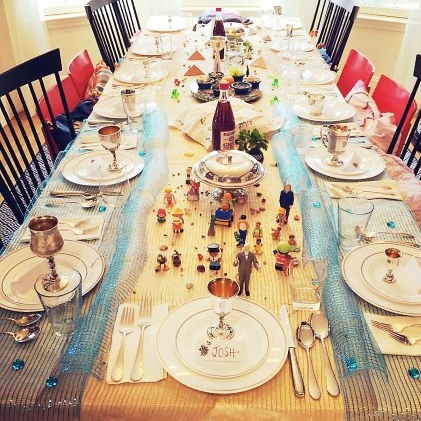click to dowload our latest edition
CLICK HERE TO SUBSCRIBE TO OUR NEWSLETTER


Published
6 years agoon
By
adminMIRAH LANGER
Other suggestions include glitter camels and pyramids hanging from the ceiling, a ping-pong ball battle to represent the plague of hail, and more. The creative list is endless.
While many of these ideas for décor and activities are about ensuring the everyone at the Seder table has fun, the intention of these matza mavens is to create a Seder space where learning is facilitated and meaningful connections are made.
Talia Scalabrino, a mother of three and with a baby on the way, has happy memories of her Afghani-Jewish traditions, saying these were the starting point for her inspiration. “We had these customs where they used to bring out silk gowns to make you feel like kings at the Seders.”
Another fond memory was how, during the singing of Dayenu, “Afghani Jews hit each other with leeks” – an action designed to re-enact the whipping of a slave. “You were allowed to hit your parents, you were allowed to hit your siblings… So, the kids all stayed up,” she explains with a laugh.
While Scalabrino has not endorsed violence with vegetables in her own household, she embraces the same spirit of trying to bring the story both to life and into the lives of her guests, young and old.
Her family’s Seders include pyramid-building speed contests and filling shot glasses with jello powder and salt, and seeing which turn to ‘blood’. They also go for a round of Marco Polo with sunglasses for ‘darkness’. Her husband dresses up in a Pharaoh costume to enact his signature scene of “pretending to be making a phone call to make the Jews work harder”.
For Scalabrino, it is ultimately not about the games, but the questions and enthusiasm they generate. She hopes they will instil “a love for Judaism” in her children.
However, the effort is not just for the children: Scalabrino believes the fun factor also enables adults to connect or reconnect to their Jewish heritage. “It forces them to be a child. It breaks boundaries because they don’t have to know everything. How many adults don’t really know what is going on, but they are just quiet because they are embarrassed and don’t want to ask the questions?.
“But when you let them loosen up – I guess the wine helps too – people ask questions about why you are doing this.”
She says that no matter the level of the guests’ religiousness, her family ensures that everyone has a chance to participate. “Everyone has to read the Haggadah in English or Hebrew. We go around the table, including men and women. It’s done properly; we don’t skip the Haggadah.”
She believes the Seder should serve as a remembrance of the meaning of the story: “We remember G-d’s hand guiding us through Egypt. We remember how lucky and blessed we are. If you look back at all the miracles that happened for us, the message is just to be grateful.”
Another keen Pesach planner, based in Johannesburg, decided on a global theme, relocating one of her Seders to the sky. “I made plane tickets that said: ‘Your destination is from Egypt to Israel, and the journey along the way is the parts of the Seder, such as drinking wine, eating matza and eating bitter herbs.’”
This year, she is sending guests a box before the Seder night, welcoming them to her home and asking them to bring one thing they would choose to bring if they had to leave Egypt tomorrow.
The real test would be if the spouses could guess the other’s selection, she laughs.
Debbie Hirschowitz, a mother of two who describes herself as “someone who is passionate about the Seders”, says she hopes her festivities leave a “lasting impression” on her guests, some of whom might never have attended a Seder before.
“You see their enjoyment. There are adults who still say to us: ‘When can we come again?’”
This is what makes the effort worthwhile, she says, admitting to sometimes “going a bit overboard”. Her favourite décor pieces are the four cups of wine that she made out of material and puts on her walls.
Debbie’s go-to resources for ideas are the aish.com and chabad.org websites, and the highlight of her family’s Seder is a rap number she has transcribed from a video off the chabad.org website. “Every year it’s a hit. We know it off by heart.”
A game she has found to be successful for both adults and children is to put various toys and objects in a bag. Each guest selects one. “They have to relate the toy to the story of Egypt; it is amazing what people come up with.”
Meanwhile, Tanya Gudelsky from Ambiance Events offers some professional tips to budding planners. On the subject of colour and themes, she says: “The story of Pesach isn’t one of roses and hydrangeas, but rather a story of the desert, G-d’s manipulation of nature, animals and so on. Bring these concepts to life on the table by using desert flowers, palm leaves, succulents and cacti instead of the traditional flowers.”
Another option, she says, is to make each guest their own “Seder plate” with their portion of all the necessary ritual foods.“Guests love this and feel so relaxed in their seats, like princes of Egypt!”
And before Pesach, Gudelsky suggests you let children draw Pesach pictures on a plain white cloth.“Use this as the tablecloth for the kiddies’ table. They will be so proud to sit at it and show their little guests.”
How does she keep kids entertained during the Seder? “Kids love prizes. End of story.”
